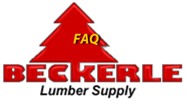Beckerle definitely sells more than lumber.
Our general product categories include, but are not limited to selling:
lumber, plywood, millwork, siding, windows, doors, cabinets, paint, and hardware.
Products and services within the categories include:
Dimension lumber and finished lumber
Common boards and finished boards
Plywood sheathing
Oriented strand board
Sheathing
Insulation
Roofing
Siding
Decking
Fencing & Seasonal Items
Nails and fasteners
Caulking
Builders hardware and residential hardware
Power Tools
Windows
Patio doors
Exterior pre-hung doors
Interior pre-hung doors
Millwork and mouldings
Custom millwork and pre-finished millwork
Cabinets
Vanities
Countertops
Kitchens
Paint & Paint Sundries
Floor and roof prefabricated trusses
Engineered wood products
A residential design service
Pressure Treated Lumber & P/T plywood
Beckerle Lumber has a FULL line of Paint & Hardware at ALL of our Stores.
So not only do we have all the BIG stuff like Lumber,Engineered wood products,plywood,doors,windows,kitchens,etc...
We also have all the small stuff.
If what you need isn’t in one of these categories we can probably still get it.
Get in touch with us and we will try to help you out.

 YES
YES YES
YES